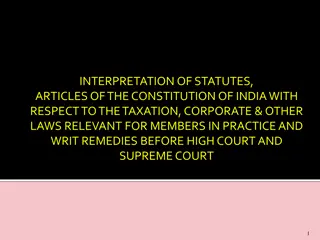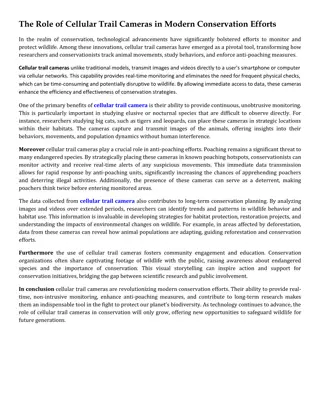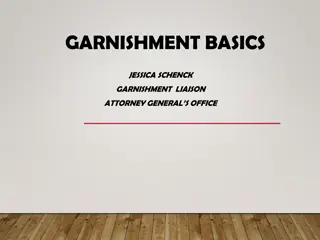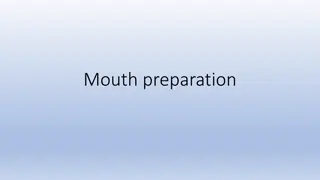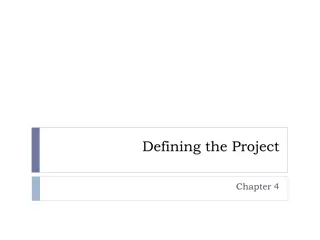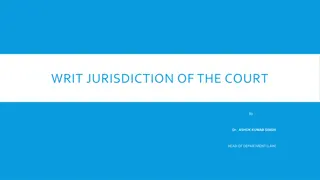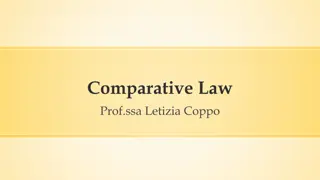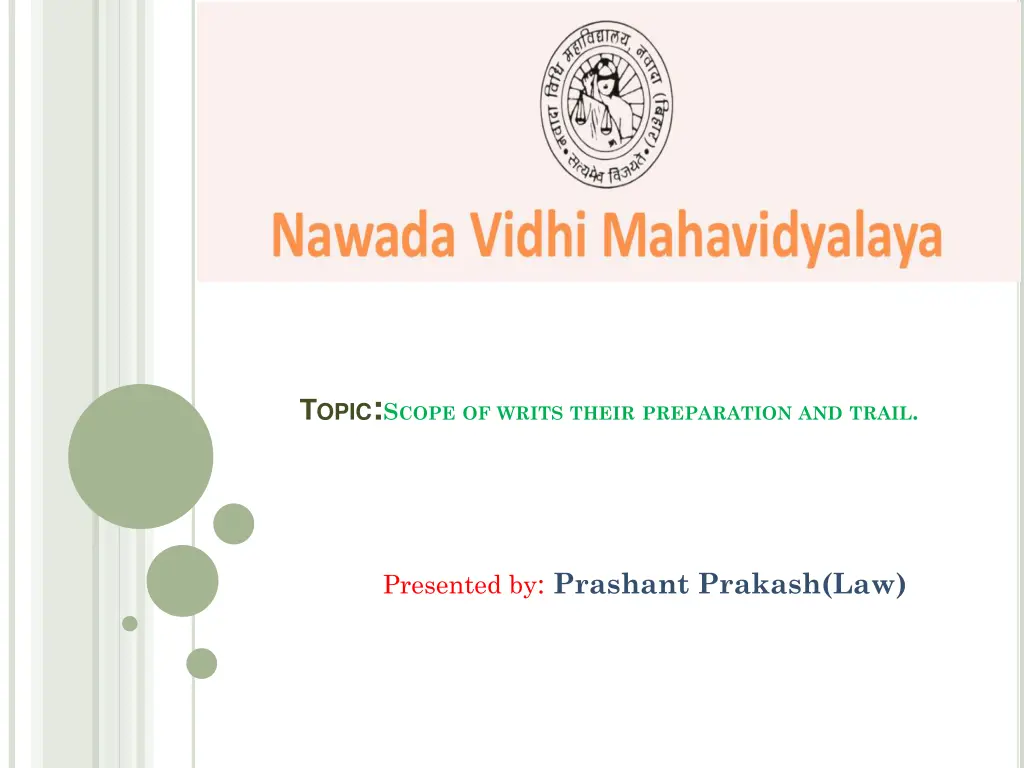
Understanding the Scope of Writs: Preparation and Application
Learn about the significance of writs in protecting fundamental rights, the distinction between Article 32 and Article 226, various types of writs like Habeas Corpus, Mandamus, Certiorari, Prohibition, and Quo Warranto, and notable cases related to Habeas Corpus.
Download Presentation

Please find below an Image/Link to download the presentation.
The content on the website is provided AS IS for your information and personal use only. It may not be sold, licensed, or shared on other websites without obtaining consent from the author. If you encounter any issues during the download, it is possible that the publisher has removed the file from their server.
You are allowed to download the files provided on this website for personal or commercial use, subject to the condition that they are used lawfully. All files are the property of their respective owners.
The content on the website is provided AS IS for your information and personal use only. It may not be sold, licensed, or shared on other websites without obtaining consent from the author.
E N D
Presentation Transcript
TOPIC:SCOPE OF WRITS THEIR PREPARATION AND TRAIL. Presented by: Prashant Prakash(Law)
MEANING A formal written order issued under a seal, in the name of authority, commanding an officer, court, sovereign etc. Under our constitution, The Supreme court and High courts are empowered to issue writs for protection of fundamental rights. Article 32 Power of Supreme court to issue writs Article 226 Power of High courts
Article 32 of the Indian Constitution gives the right to individuals to move to the Supreme Court to seek justice when they feel that their right has been unduly deprived . The apex court is given the authority to issue directions or orders for the execution of any of the rights bestowed by the constitution as it is considered the protector and guarantor of Fundamental Rights The Article 226 empowers High Courts to issue directions, orders or writs in the nature of habeas corpus, mandamus, prohibition, quo warranto and certiorari. Such directions, orders or writs may be issued for the enforcement of fundamental rights or for any other purpose
Both art.32 and art.226 issue writs but there are 2 major differences between them. Article 32 Article 226 1.The power to issue writs are only limited to protection of fundamental rights 2. As it falls under part IIIrd, it is a fundamental right 1.Writs can be issued against fundamental rights as well as for another purpose Ex: Administrative tribunals 2. Remedy under article 226 is not a fundamental right
TYPES OF WRITS 1. Habeas corpus 2. Mandamus 3. Certiorari 4. Prohibition 5. Quo Warranto
HABEAS CORPUS To have a body or to produce a body One of the important writs for personal liberty This writ provides immediate relief in case of unlawful detention Writ of Habeas Corpus is issued if an individual is kept in jail or under a private care without any authority of law A criminal who is convicted has the right to seek the assistance of the court by filing an application for writ of Habeas Corpus if he believes that he has been wrongfully imprisoned
CASES 1. ADM Jabalpur v. Shivakant Shukla (1976) 2 SCC 521 it was held that the writ of Habeas Corpus cannot be suspended even during the emergency (Article 359) 2. Narayan v. Ishwarlal AIR 1965 SC 1818 While deciding whether Habeas Corpus writs are civil or criminal in nature, it was held that the court would rely on the way of the procedures in which the locale has been executed. 3. Rudal Shah vs. State of Bihar AIR 1983 SC 1086 A person who had already completed his period of detention was still kept in jail for 14 yrs extra. Here writ of habeas corpus was used and he was immediately released and he was also given exemplary damages.
MANDAMUS It means we command This writ is issued for the correct performance of mandatory and purely ministerial duties and is issued by a superior court to a lower court or government officer. It safeguards the public from the misuse of authority by the administrative bodies. The person applying for mandamus must be sure that he has the legal right to compel the opponent to do or refrain from doing something. Its main purpose is to ensure that the powers or duties are not misused by the administration or the executive and are fulfilled duly.
CONDITIONS FOR ISSUE OF MANDAMUS There must rest a legal right of the applicant for the performance of the legal duty. The nature of the duty must be public. On the date of the petition, the right which is sought to be enforced must be subsisting. The writ of Mandamus anticipatory injury. is not issued for
CASES Manjula Manjori v. Director of Public Instruction, the publisher of a book had applied for the writ of mandamus against the Director of Public Instruction for the inclusion of his book in the list of books which were approved as text-books in schools. But the writ was not allowed as the matter was completely within the discretion of D.I.P and he was not bound to approve the book
Gujarat State financial corporation vs. Lotus Hotels Financial cooperation had an agreement with the Lotus hotels that we will release the funds so that you can complete your construction work, but later on they refuse to release the funds and Lotus hotels approach Gujarat High court and HC by using this writ directs the authority to perform the public duty which it promised to perform.
CERTIORARI Writ of Certiorari means to be certified. It is issued when there is a wrongful exercise of the jurisdiction and the decision of the case is based on it. The writ can be moved to higher courts like the High Court or the Supreme Court by the affected parties. There are several grounds for the issue of Writ of Certiorari. Certiorari is not issued against purely administrative or ministerial orders and that it can only be issued against judicial or quasi-judicial orders.
WHEN IT CAN BE ISSUED It is issued to quasi-judicial or subordinate courts if they act in the following ways: Either without any jurisdiction or in excess. In violation of the principles of Natural Justice. In opposition to the procedure established by law. If there is an error in judgment on the face of it. T.C. Basappa v. T. Nagappa & Anr. 1954 AIR 240, it was held by the constitution bench that certiorari maybe and is generally granted when a court has acted (i) without jurisdiction or (ii) in excess of its jurisdiction.
PROHIBITION It is a writ directing a lower court to stop doing something which the law prohibits it from doing. Its main purpose is to prevent an inferior court from exceeding its jurisdiction or from acting contrary to the rules of Natural Justice. When it can be issued ? 1. It is issued to a lower or a subordinate court by the superior courts in order to refrain it from doing something which it is not supposed to do as per law 2. It is usually issued when the lower courts act in excess of their jurisdiction 3. It can be issued if the court acts outside its jurisdiction
In Bengal Immunity Co. Ltd AIR 1955SC 661 the Supreme Court pointed out that where an inferior tribunal is shown to have seized jurisdiction which does not belong to it then that consideration is irrelevant and the writ of Prohibition has to be issued as a right. QUO WARRANTO It means by what authority By using this writ court can question any public officers that by what authority have you assumed this public office ? And if the officer s title is defective then he has to vacate the office
Baij vs. State of U.P Where the holder of an office has been continuing in office for a long time and there is no complaint against him the court refused the writ as it would have been vexatious


